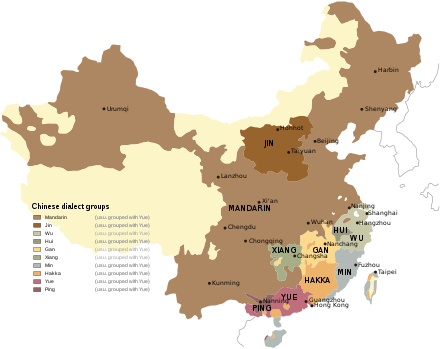Language Atlas of China
The Language Atlas of China (simplified Chinese: 中国语言地图集; traditional Chinese: 中國語言地圖集; pinyin: Zhōngguó Yǔyán Dìtú Jí), published in two parts in 1987 and 1989, maps the distribution of both the varieties of Chinese and minority languages of China. It was a collaborative effort by the Australian Academy of the Humanities and the Chinese Academy of Social Sciences, published simultaneously in the original Chinese and in English translation.[1] Endymion Wilkinson rated this joint venture "outstanding".[2]
| Author | Stephen Adolphe Wurm, Rong Li, Theo Baumann, Mei W. Lee |
|---|---|
| Publisher | Longman |
Publication date | 1987, 1989 |
| ISBN | 978-962-359-085-3 |
A second edition was published in 2012.
Classification of Chinese varieties

The atlas organizes the varieties of Chinese in a hierarchy of groupings, following the work of Li Rong:[3]
- supergroups (大区 dàqū): Mandarin and Min
- groups (区 qū): Jin, Wu, Hui, Xiang, Gan, Hakka, Yue, Pinghua and groups within Mandarin and Min
- subgroups (片 piàn)
- clusters (小片 xiǎopiàn) are only identified for some subgroups
- local dialects (点 diǎn): localities that were surveyed
Contents
The atlas contains 36 colour maps, divided into three sections:[3]
- A. General maps
- A1 Languages in China
- A2 Chinese dialects in China
- A3 National minorities in China
- A4 Minority languages in China
- A5 Language distribution (Guangxi Zhuang Autonomous Region)
- B. Maps of Chinese dialects
- B1 Mandarin-1 (Northeastern China)
- B2 Mandarin-2 (Beijing, Tianjin, Hebei and western Shandong)
- B3 Mandarin-3 (Henan, Shandong, northern Anhui, northern Jiangsu)
- B4 Mandarin-4 (Shaanxi, Gansu, Qinghai, Ningxia)
- B5 Mandarin-5 (Xinjiang Uygur Autonomous Region)
- B6 Mandarin-6 (Southwestern China)
- B7 Jin group (Shanxi and adjacent areas)
- B8 Chinese dialects (southeastern China)
- B9 Wu group (Zhejiang, Shanghai, southern Jiangsu)
- B10 Chinese dialects (southern Anhui area)
- B11 Chinese dialects (Hunan and Jiangxi)
- B12 Min supergroup (Fujian, Taiwan, eastern Guangdong and Hainan Island)
- B13 Chinese dialects: Guangdong (mainland)
- B14 Chinese dialects (Guangxi Zhuang Autonomous Region)
- B15 Hakka group
- B16 Chinese dialects overseas: (a) insular Southeast Asia (b) other parts of the world
- C. Maps of minority languages
- C1 Minority languages in northern China
- C2 Mongolian languages
- C3 Mongolian dialects
- C4 Turkic (Tujue) languages
- C5 Manchu-Tungus languages
- C6 Minority languages in southern China
- C7 Kam-Tai languages
- C8 Miao-Yao languages
- C9 Dialects of the Miao language
- C10 Tibeto-Burman stock languages
- C11 Tibetan dialects
- C12 Minority languages (Guangxi Zhuang Autonomous Region)
- C13 Minority languages (Yunnan province)
- C14 Minority languages on Hainan and Taiwan islands
The maps are printed on loose white sheets measuring 15 in (38 cm) by 20.75 in (52.7 cm). Each map is accompanied by a blue sheet of the same size containing explanatory notes.[1]
Second edition
Work began on revised edition in 2002.[2] The work was published in 2012 as a joint venture between the Chinese Academy of Social Sciences and the City University of Hong Kong. It consists of two volumes, dealing respectively with varieties of Chinese and minority languages.[4][5] The revision follows the same structure as the first edition, but the number of maps has increased to 79, and the explanatory text is greatly expanded. The number of minority languages covered has also increased from 81 to 130.[6]
See also
- Language of China
- Demographics of the People's Republic of China
- Languages of Hong Kong
- Languages of Macau
References
- Baker, Hugh D.R (1993). "Language Atlas of China". Bulletin of the School of Oriental and African Studies. 56 (2): 398–399. doi:10.1017/S0041977X0000598X.
- Wilkinson, Endymion (2012). Chinese History: A New Manual. Harvard-Yenching Institute Monograph Series (Second, Revised printing March 2013 ed.). Cambridge, MA: Harvard University Asia Center. p. 30. ISBN 978-0-674-06715-8.
- Kurpaska, Maria (2010). Chinese Language(s): A Look Through the Prism of "The Great Dictionary of Modern Chinese Dialects". Walter de Gruyter. pp. 63–64. ISBN 978-3-11-021914-2.
- "Zhōngguó yǔyán dìtú jí (dì 2 bǎn): Hànyǔ fāngyán juǎn" 中国语言地图集(第2版):汉语方言卷 [Language Atlas of China (2nd edition): Chinese dialect volume]. Beijing: The Commercial Press. Retrieved 10 January 2017.
- "Zhōngguó yǔyán dìtú jí (dì 2 bǎn): shǎoshù mínzú yǔyán juǎn" 中国语言地图集(第2版):少数民族语言卷 [Language Atlas of China (2nd edition): Minority languages volume]. Beijing: The Commercial Press. Retrieved 10 January 2017.
- Xu, Ruiyuan 徐睿渊 (2014). 《中国语言地图集》(第2版)评介 [Language Atlas of China (2nd edition): review]. CASS. Retrieved 13 January 2017.
External links
- "Digital Language Atlas of China", compiled by Lawrence W. Crissman, version 6, 5 October 2012, Australian Centre for the Asian Spatial Information and Analysis Network (ACASIAN) GIS Data Archive. The full dataset consists of eight layers in ESRI shapefile format derived from the Language Atlas of China. The initial release (under Creative Commons v3.0 – Attribution-NonCommercial-ShareAlike) contains only a draft of the first layer, representing maps A1–4 and marking language families and major Chinese dialect groups, but not individual non-Chinese languages or subgroups of Chinese dialects.